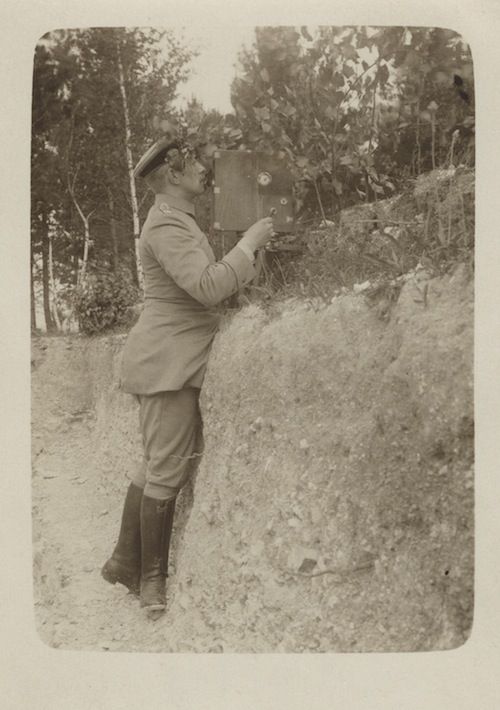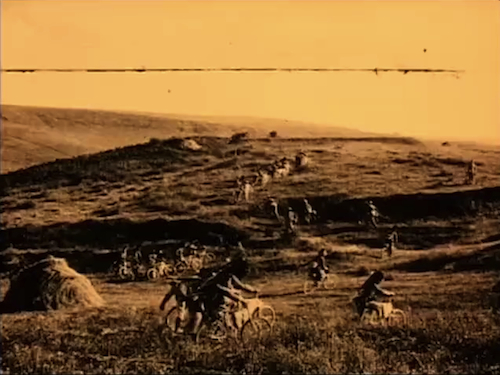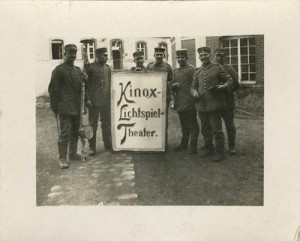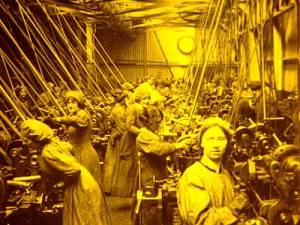Click here to print
The Great War in Film and Cultural Memory
posted February 3, 2014
“Europeana 1914-1918,” a vast online amalgamation of resources relating to World War I, includes some 660 hours of film reflecting the military and civilian involvement of many nations
n

‘Cameraman Wolfgang Filzinger’. Credit: Deutsches Filminstitut-DIF/Wolfgang Filzinger Estate.
Few decades in modern times have passed without intra-European warfare. Far from fulfilled has been the hope that the First World War of 1914-1918 would be the war to end all wars.
The Great War began 100 years ago. To mark the centenary, Europeana, a vast pan-European digital library of historical resources with numerous associated projects, has launched Europeana 1914-1918, a trove of World War I source material, including 660 hours of film material.
“It’s a unique collection of raw materials – rare, fragile, and hardly seen before,” said Jill Cousins, the executive director of Europeana, at the project’s Berlin launch on 28 January 2014. “We’re encouraging everyone — history teachers, Wikipedians, apps developers — to use it in new ways. Most of the content is under an open licence, because we want people to re-use it to help broaden everyone’s understanding of our European past.”
Some parts of the Europeana 1914-1918 collection of collections have been in development for a few years. That includes European Film Gateway 1914. A coalition of 28 European film archives, such as the Imperial War Museums, Cinémathèque Royale de Belgique, and EYE Film Institute of the Netherlands, collaborated to digitize the films, which include newsreels, documentaries, fiction films, propaganda, and anti-war films. As is the case with all silent film made during the era of the war, only a small proportion of material survive – about 20 percent, in the case of war-related footage.
The film project is one of three major European efforts that have come together as Europeana 1914-1918. One of the two other components is Europeana Collections 1914-1918, which has produced a digital resource of more than 400,000 items from national libraries in eight countries that found themselves on different sides of the historic conflict.
‘Oorlogsannalen N° 85 / Les Annales de la Guerre N° 85’, France 1918. Source: Deutsches Filminsitut – DIF. From European Film Gateway 1914.
The third project incorporated in Europeana 1914-1918 is a collection of stories and memorabilia contributed by members of the European and British public. That part of the project is ongoing — anyone interested in contributing such items relating to World War I experiences and events as unpublished letters, photographs, and keepsakes is invited to do so from a form on the project website. Some partner institutions have created moving online feature segments to encourage participation.
To encourage contributions of material, the Europeana 1914-1918 project is running a series of “family history roadshows” around Europe where anyone may bring items for curators to digitize. Oxford University has taken the lead in those activities, which have been held in 12 countries, with 5 more to come during 2014. To date, the roadshows have gathered more than 90,000 items and 7,000 stories from the thousands of members of the public who have attended them.
Europeana 1914-1918 organizers say that among their most important goals has been to bring together the public-history resources of national museum and film collections and personal stories and treasures. That, they believe, will spark fresh insights into the War.
‘Dans les ajoncs du Vardar’, France 1916, Pathé Frères. Source: EYE Film Instituut Nederland. From European Film Gateway 1914.
Those may come from such Europeana project resources as 400,000 rare documents — photos, censorship cards, posters, texts… — digitised by 10 state libraries and two other partners in Europe; 90,000 personal papers and memorabilia of some 7,000 people involved in the war, held by their families and digitised at the “roadshow” events; and the 660 hours of film material digitised by audiovisual archives.
The Europeana 1914-1918 web portal also provides access to various European collections and projects, as well as information from institutions outside Europe, including the Digital Public Library of America, Trove (Australia), and Digital New Zealand.
Launching the Europeana project in Berlin, the German Minister of Culture, Monika Grütters, said it was the pan-European nature of the project that set it apart: “It shows the stark difference between the European disruptions of that time and our way of cooperating nowadays. It is vital for the Government to point out, especially to young people, that today’s Europe is a union based on shared values, policies, and justice. That’s the best way to avoid the wars, terror and fragmentation that Europe suffered in the 20th century.” The project will “make a great contribution to the mutual understanding of the European people, despite the conflicts of history.”
Already offering material for secondary and tertiary teachers, journalists, and anyone else who might take interest is an outstanding new online resource that the British Library developed, called simply World War One. Among its diverse trove of materials and analyses, it offers copies and explanations of such items as digitized photographs, maps, diaries, newspapers, letters, and drawings. Already in the overall Europeana collection were items reflecting life in the trenches or in the rear, in the colonies or at home, including rare items such as trench newspapers and censored letters sent home by troops.
Alongside the original documents and images on the World War One site are short films, essays, and interviews with European experts on key aspects of the war and its aftermath, such as the shifting boundaries of Europe; the roles of technology and propaganda in the war; and the class and gender struggles that emerged from WW1 to transform Europe.
‘Oorlogsannalen N° 85 / Les Annales de la Guerre N° 85’, France 1918 ; Source : Deutsches Filminsitut – DIF. From European Film Gateway 1914.
At a two-day conference held at the State Library of Berlin to mark the launch of Europeana 1914-1918 at the end of January 2014, some 300 collections experts from around Europe gathered to consider the nature and possibilities of the amalgamated collections. Among their activities was to attend a presentation of select items from the European Film Gateway collection.
The German Film Institute (Deutsches Filminstitut) is in charge of the film-collecting portion of Europeana 1914-1918. Its director, Claudia Dillmann, said: “The contribution that film makes to our understanding of the period is immense. Barely 20% of the silent film produced at the time has survived and most of the newsreels, documentaries, fiction, and propaganda that we have put online have not been seen by the public for a century. We have also digitized anti-war films that reflect on the catastrophe at first hand.” Those anti-war films generally appeared after 1918, and reflected on the tragedies of the conflict.
The driving force behind the film portion of Europeana 1914-1918 was that much of the film material produced in the decade of the 1910s related to the events of World War One, but most of it was not available for public use because it was shelved in archives, in analog format.
Curators intend the film material to cover all genres and sub-genres of that time, including newsreels, documentaries, fiction films, propaganda films. And the 26 partner institutions, working since February 2012, have gathered images from all phases and locations of the Great War. In addition, they have digitized some 5,500 film-related documents.

“Italienske Alpejægere / Bersaglieri d´Italia alle grandi manovre”, Italy 1915; Source: Det Danske Film Institute. From European Film Gateway 1914
Click on image to view film.
n
Titles and descriptions of the films provide a sense of their great variety, and of their range from matters of great international import to events of significance primarily to individuals and families: the assassination of Archduke Franz Ferdinand in Sarajevo; a prisoner-of-war camp in Feldbach, Germany; Vienna during the war; the production of a soldier’s uniform; Emperor Karl, the last ruler of the Austro-Hungarian Empire, in Tyrol; devastation in such cities as the conquered Tolmezzo, Grado, and Udine, Italy; a bombshell arsenal; fighting at the Turkish front; German and British newsreels; and Mars na Drinu (March on the Drina), a 1964 feature film recreating the heroism of a Serbian artillery battery during the Battle of Cer.
Members of the public may offer film and film-related material for digital addition to the collection through the European Film Gateway site.

‘Camera team of Wolfgang Filzinger’, about 1915. Credit: Deutsches Filminstitut – DIF/ Wolfgang Filzinger Estate.
Partners in European Film Gateway 1914
Deutsches Filminstitut – DIF e.V., Germany – project coordinator
Deutsche Kinemathek – Museum für Film und Fernsehen, Germany
Reelport GmbH, Germany
Fraunhofer Institute for Integrated Circuits IIS, Germany
Arhiva Nationala de Filme, Romania
Association des Cinémathèques Européennes, German/Belgium
Athena Research and Innovation Center in Information Communication & Knowledge Technologies, Greece
Centre national du cinéma – Archives françaises du Film, France
Cinecittá Luce S.p.A, Italy
Cinémathèque royale de Belgique
CNR-Istituto di Scienza e Tecnologie dell´Informazione, Italy
CulturArts Generalita – Unidad de Audiovisual y Cinematografía, Spain
Det Danske Filminstitut, Denmark
Estonian Film Archive
EYE Stichting Film Instituut Nederland, The Netherlands
Filmarchiv Austria
Fondazione Cineteca Italiana
Fondazione Cineteca di Bologna
Imperial War Museums, UK
Instituto de la Cinematografia y Artes Audiovisuales – Filmoteca Española
Jugoslovenska Kinoteka, Serbia
Hungarian National Digital Archive
La Cineteca del Friuli, Italy
Národní filmový archiv, Czech Republic
Nasjonalbiblioteket, Norway
Österreichisches Filmmuseum, Austria

‘Fabrication des munitions et du matériel de guerre’ UK 1916 (?). Credit: CNC-AFF.
Printed from Moving Image Archive News: http://www.movingimagearchivenews.org
URL to article: http://www.movingimagearchivenews.org/the-great-war-in-film-and-cultural-memory/
Click here to print